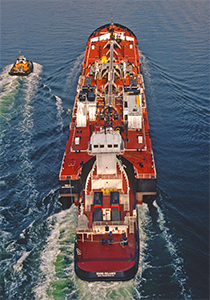Vessel operators on the West Coast of North America have been slower to adopt articulated tug-barge technology than East Coast companies, with many in the industry saying North Pacific seas are too rough for ATBs. Inroads have been made, but there has been controversy after two recent incidents off the coast of British Columbia.
One of the first to make the move to the technology on the Pacific Coast was Crowley Maritime, shortly after the ATB tug Sound Reliance was delivered by VT Halter Marine in 2002. The 126-foot tug is coupled to 550-2, a 155,000-barrel barge. With the tug in the notch, the total unit is 587 feet long.
Should Sound Reliance become uncoupled from its barge, the ATB is rigged with emergency towing gear. A messenger line is made up from the tug to the stern quarter of the barge when they are at sea. The towline would allow the tug to hold the barge in position until another tug arrives to pick up the barge’s bow-mounted towline. An H-bitt on Sound Reliance’s aft deck allows the barge to be towed with either line.
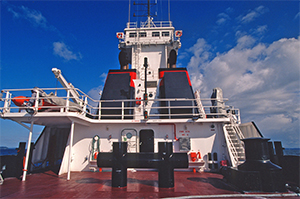 |
|
A stout H-bitt on the aft deck of Sound Reliance can be used for towing in an emergency. The ATB tug is one of four in Crowley’s 550 class on the West Coast, all featuring Intercon notch connection systems on the business end. |
|
Alan Haig-Brown photo |
Another early adopter of ATB technology on the Pacific Coast was British Columbia-based Island Tug and Barge, which converted the classic 1966-built, twin-screw tug Island Monarch by adding a pair of Intercon connectors to its bow. Unlike most purpose-built ATB tugs, Island Monarch is equally prepared to push or to tow. The tug makes better time and saves on fuel when pushing in the notch, but the captain decides — based on the weather before entering open water — if he will make up to tow or continue pushing. This avoids the more time-consuming chore of switching from pushing to towing when at sea.
More recently, two new players in the ATB market have entered West Coast service. Both have experienced dramatic failures.
The first incident was the grounding of the U.S.-flagged ATB tug Nathan E. Stewart, built in 2001 and operated by Houston, Texas-based Kirby Corp. In October 2016, the tug and its barge, DBL 55, transported a cargo of jet fuel and gasoline from the Port of Vancouver to Alaska. The ATB discharged its cargo in two ports and took on more than 23,000 gallons of fuel oil for the return trip. The ATB units were coupled by their JAK system, with the pins engaged in the slot second from the bottom of the empty barge.
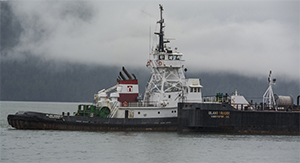 |
|
Island Monarch moors with the barge Island Trader at the Island Tug and Barge facility on Burrard Inlet in British Columbia. |
|
Alan Haig-Brown photo |
On Oct. 13, Nathan E. Stewart ran aground on the central coast of British Columbia near the community of Bella Bella. By the time the tug was salvaged just over a month later, it had spilled 29,000 gallons of fuel and lube oil. Investigators determined that the cause of the grounding was a combination of the watchkeeper falling asleep and the crew’s failure to follow Kirby’s safety management system, which required a second licensed deck officer to augment the watch. The watchkeeper — the second mate — also had not activated an alarm that sounds when the vessel leaves its prescribed course.
Canadian regulations typically require a local pilot to guide most commercial vessels through the Inside Passage. Some Kirby vessels, including Nathan E. Stewart, earned a waiver based on the experience of the captain and chief mate in navigating the waterway. The second mate was not covered by the exemption, however, and the captain was not aware of the pilotage rules or the waiver requirements, according to a report by the National Transportation Safety Board (NTSB).
These pilotage exemptions are long established. For the central coast of British Columbia, an exemption is gained by making 20 transits with a qualified officer of the five different sets of waters. The relevant one in this case can be described as the passage between the Alaska-B.C. border and Pine Island, which is just inside the northern tip of Vancouver Island.
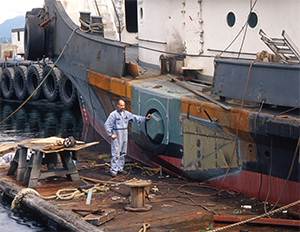 |
|
Intercon pins were added to the traditional twin-screw Island Monarch in the early 2000s in its conversion to an ATB. |
|
Alan Haig-Brown photo |
However, Canadian regulators decided that vessels pushing or towing oil cargoes should be required to avoid central coast waters by “going outside” in the Hecate Strait. This is common practice in fair weather, even for tugs towing container barges to Alaska, but the relatively shallow strait is notorious for its heavy weather. In acknowledgement of this, a provision was made for tugs and barges to take the protected “inside” route through Laredo Sound and Principe Channel after informing Marine Communications and Traffic Services.
The second incident, which occurred on Nov. 26 last year, involved the 111-by-36-foot tug Jake Shearer and its laden 80,000-barrel oil barge Zidell Marine 277. The U.S.-flagged ATB, owned by Harley Marine Services, was navigating north through British Columbia to Alaskan waters and, as required by regulations, the captain had set a course that would take him outside of Calvert Island and the restricted waters of the Inside Passage. The ATB continued northward below Goose Island, where large waves twisted the connection of the tug and barge to such an extent that the barge broke free.
Joey Greene, captain of some of the largest trawlers on the B.C. coast, knows the waters around Goose Island and Goose Bank well. “We have lost a few boats and friends there,” he said. “The problem in southeast gales when you get close to Goose Island is that the ebb tide, flowing out of Milbanke and Laredo sounds and Hecate Strait, is running against the wind and can build some big seas and deep troughs.”
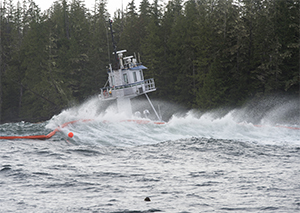 |
|
Storm waves batter Nathan E. Stewart and the containment boom surrounding it in early November 2016, three weeks after the ATB tug ran aground off Athlone Island, British Columbia. An estimated 29,000 gallons of diesel fuel and lube oil spilled from the vessel into Heiltsuk Nation waters. |
|
Photo courtesy Heiltsuk Nation/April Bencze |
There was some heroic work by two crew who boarded the drifting barge and skillful handling by Jake Shearer’s captain, who used the tug to nudge the barge away from the rocks until help arrived. Eventually the barge was taken in tow by a conventional tug and, after inspection, on to Ketchikan for repairs. Jake Shearer returned to Seattle under its own power.
With ATBs involved in two serious incidents in some of the West Coast’s most pristine waters, there remain questions regarding the best way to transport petroleum products to Alaska. Traditional towed barges have used the Inside Passage for decades with minimal problems, and smaller coastal product tankers have demonstrated an ability to cope with more severe weather offshore. But ATBs are faster than conventional tug-and-barge combinations and are less expensive than tankers. A typical tanker with a capacity of about 330,000 barrels will have 21 crewmembers, while an ATB with similar capacity requires only 14 — a significant labor cost savings.
The Canadian government, anxious to earn export revenues, has promised the most advanced technology to protect the coast from spills. Meanwhile, U.S. maritime companies continue to operate under the “best available technology” requirements of the Oil Pollution Act of 1990 (OPA), which resulted from the Exxon Valdez disaster. The Heiltsuk Nation, in whose territory both of the recent ATB incidents occurred, isn’t satisfied with the protections and wants more to be done.
Eleven days before Jake Shearer’s barge broke free, the Heiltsuk Tribal Council released a report titled “Creating a World-Leading Response System.” It calls for a program in Heiltsuk territory staffed by a trained crew familiar with the local marine environment, with vessels and equipment expressly designed for central coast conditions and able to respond to all incidents in the study area in five hours or less.
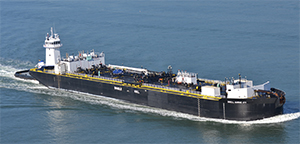 |
|
The ATB tug Jake Shearer and its barge, Zidell Marine 277, enter Vancouver Harbor in late October to take on cargo. In November, the barge, which was laden with oil, became uncoupled from the tug in heavy seas near Goose Island, British Columbia. |
|
Photo courtesy Robert Etchell |
Apart from crude-oil tankers operating well offshore, the trend is very much toward an increase in ATB fleets. In January, Crowley announced that it would build a 100,000-barrel ATB for transporting product between the U.S. West Coast and Alaska, with vessel delivery set for late 2019. “While Crowley has operated ATBs in Alaska in the past, this will be the first ATB of its size and class that will be dedicated to the Alaska market,” said Rocky Smith, Crowley Fuels’ senior vice president and general manager.
The Alaska-class ATB from Bollinger Shipyards will be 483 feet overall and feature extra framing and a ship-shape bow to enhance maneuverability in icy conditions. The tug will have azimuthing drives and an Intercon coupling system. Although not required for domestic operation by U.S. or Canadian authorities, the new ATB will be classed for SOLAS (Safety of Life at Sea).
Dale Sause, president and CEO of Sause Bros., has been considering the ATB option for years while growing one of the most modern towed oil-barge fleets in the United States. His largest towed barges have the capacity for 100,000 barrels of product. Several years ago, he had an ATB designed that consists of a 150,000-barrel barge with an 8,000-hp tug. The tug will have a 5:1 reduction gear turning Nautican propellers in nozzles.
“We have several customers who have expressed interest in it and our 110,000-barrel design,” Sause said, adding that he considers the ATB to be a viable option only with “safe weather operating parameters established by model testing or CFD (computational fluid dynamics) analysis.”
It is likely that after the recent incidents off British Columbia, there are a good number of Canadian and U.S. officials meeting to try to define appropriate design, crewing and routing regulations to cover the growth of the ATB phenomenon.

